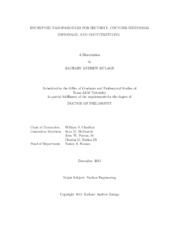| dc.contributor.advisor | Charlton, William S | |
| dc.creator | Kulage, Zachary Andrew | |
| dc.date.accessioned | 2016-05-04T13:15:54Z | |
| dc.date.available | 2016-05-04T13:15:54Z | |
| dc.date.created | 2013-12 | |
| dc.date.issued | 2013-11-04 | |
| dc.date.submitted | December 2013 | |
| dc.identifier.uri | https://hdl.handle.net/1969.1/156355 | |
| dc.description.abstract | Acts of terrorism and the use of explosives raise concerns about what can be done to prevent such acts. From stopping such a threat to preventing the illicit counterfeiting and smuggling of sensitive and proprietary goods, identification taggant technology can be applied to identify and interdict materials of a dubious nature. This cost effective approach to tag and track materials will find application in both the government and private sectors, particularly in the prevention of corporate espionage.
A taggant system was created based on the modification of the natural isotopic vector of cadmium and tellurium to create artificial, unique, and robust identification capabilities. A proof of concept trial was undertaken to ascertain the effectiveness, reliability, and integrity of a system. Stable isotopes were mixed in various combinations to alter the isotopic vector and then neutron activation analysis techniques were used to evaluate the quality of the taggants. Two different neutron activation analysis facilities of differing capabilities were employed to test the limitations of the method in detection of trace amounts of taggant material.
Testing of the taggant system found that solid phase taggants were capable of producing around 14,000 unique taggants for under $250 each while liquid phase taggants were capable of producing around 2,000 unique taggants for under $50 each. Common research reactors were also shown to be effective for use in a taggant system for certain isotopic vectors. | en |
| dc.format.mimetype | application/pdf | |
| dc.language.iso | en | |
| dc.subject | Neutron Activation Analysis | en |
| dc.subject | TRIGA | en |
| dc.subject | HFIR | en |
| dc.subject | Bateman Equation | en |
| dc.subject | Stable Isotopes | en |
| dc.title | Encrypted Nanoparticles for Security, Counter-industrial Espionage, and Counterfeiting | en |
| dc.type | Thesis | en |
| thesis.degree.department | Nuclear Engineering | en |
| thesis.degree.discipline | Nuclear Engineering | en |
| thesis.degree.grantor | Texas A & M University | en |
| thesis.degree.name | Doctor of Philosophy | en |
| thesis.degree.level | Doctoral | en |
| dc.contributor.committeeMember | McDeavitt, Sean M | |
| dc.contributor.committeeMember | Poston, John W | |
| dc.contributor.committeeMember | Folden, Charles M | |
| dc.type.material | text | en |
| dc.date.updated | 2016-05-04T13:15:55Z | |


